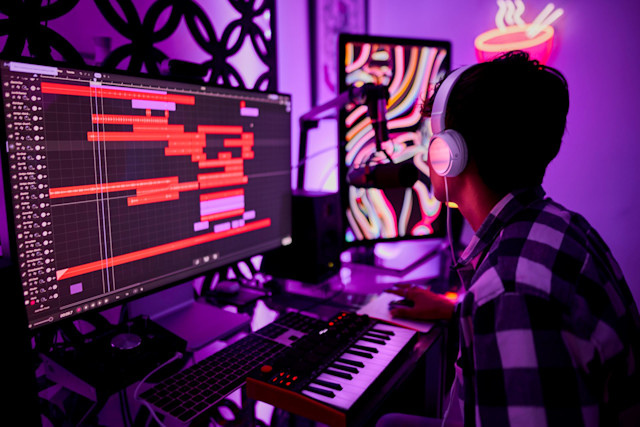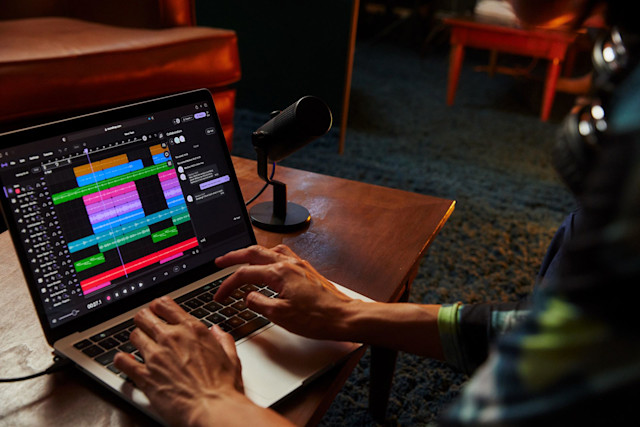How to make your beats more interesting: The definitive guide
September 23, 2024 - Discover how to create addictive and professional beats. Learn the techniques used by the most successful producers.

In the art of music production, beats are the heart of any track. You can have an amazing melody, but if the beat doesn't grab or hold the listener's interest, the track loses steam. This article is designed to give you a series of techniques and tips that will not only make your beats sound better, but give them life and character. We'll cover everything from tweaking beats to incorporating unique sounds and creative collaborations with other producers. This guide will help you keep the freshness in every beat you create, making sure your productions always have something interesting to offer.
1. Use patterns of at least 8 bars
One of the most common mistakes among beginner producers is to keep repeating 4 bar patterns without variation. While this may work for certain minimal genres, the reality is that a repetitive beat tends to get monotonous very quickly. Extending your patterns to 8 bars or more gives you the opportunity to develop more complex and varied rhythmic ideas.
Why 8 bars? Because it allows you to tell a story within the beat and it is harder for the human ear to lose interest since it will be hearing something new or varied over a longer period of time. You can divide that space into sections: the first 4 bars introduce the groove, while the last 4 can introduce subtle variations like a change in percussion or a slight tweak in effects. It's like a mini-trip for the listener, keeping them hooked and expectant of what comes next.
2. Chord Arrangement Variations
Don't limit yourself to one chord progression for the entire song. Changing chord arrangements over the course of the beat is a powerful way to keep the listener's attention. This doesn't mean you have to change the entire progression, but you can play with chord inversions, add passing notes, or move chords to different octaves.
For example, you can start with a basic arrangement in the first section of the beat, but then invert the chords (change one or several notes of the chord to another octave) for the second part, or add tension with suspended chords. This technique is perfect if you work with more melodic genres like future bass, melodic trap or even lo-fi hip hop. The subtle change of the harmonic structure will make the beat evolve constantly without the need to overload it.
3. Dynamic effect automations
Automation is a key tool that separates professional producers from novices. Don't limit yourself to static reverb and delay effects; use dynamic automation to create variations in the beat. A useful trick is to automate the frequency of a filter or the amount of reverb on certain rhythmic elements so that they change gradually over the course of a section.
Imagine a hi-hat that starts out dry, but by the end of the beat is submerged in a spacey reverb. These kinds of subtle changes add a lot of dynamics and keep the beat from feeling flat. You can also automate other effects such as saturations, modulations. Something that works very well is panning your elements, making the sounds travel from one side of the stereo space to the other, giving a three-dimensional feel to your production.
4. Off-Grid Drumming
Programming off-grid percussion can give your beat a more organic and less mechanical feel. Many successful producers, such as J Dilla and Flying Lotus, are known to use this approach in their beats. Slightly moving snare hits or hi-hats out of perfect time can make your beat sound more human, as if it were played by a real person instead of a machine.
This doesn't mean completely disorganizing your rhythmic elements, but shifting some beats to make them sound more natural and dreamy with more Groove. In fact, many DAW plugins allow you to adjust the swing or quantize to get this effect precisely. Experiment with different levels of “misalignment” to find the perfect point between precise and organic.

5. Playing with octave shifts
A simple but effective change to keep the listener's interest is to move your melodies or samples between different octaves (even percussion with a few more processes). By switching from a low octave to a high octave at certain points in the beat, you can introduce tension and release energy in a controlled way.
Think of it as a dialogue between bass and treble. A deep bass can “speak” in one section of the beat, while a high-pitched melody responds in another. This type of interaction generates movement within the beat, keeping the dynamics going and the listener interested in what comes next.
6. The power of silence
Silence is an underrated tool in music production. Sometimes the absence of sound can be as powerful as any instrument or effect. By incorporating strategic pauses or reducing the beat to just a few elements, you create a sense of anticipation that can give more impact to the elements that follow.
The trick is knowing when to use silence. Try cutting all the low frequencies for a beat before the beat drops back down hard, or eliminate certain or all elements for a couple of seconds to make the return more dramatic. This is a common trick in EDM and trap, where the “drop” or return of the beat is key to generating a strong reaction in the listener.
7. Incorporation of Foley effects
Foley effects are recorded ambient sounds, such as footsteps, the closing of a door or the sound of a lighter. Including these effects in your beat can give it a unique texture and special character. Instead of just using conventional drum and percussion sounds, Foley effects add an extra layer of interest and context.
For example, you could add the sound of a typewriter as a percussive beat in the background, or use the sound of rain to create a deeper atmosphere. You can also add, depending on the style, sounds of gunshots, screams, ambulances or sirens, etc. These details may be subtle, but they help make your beat sound different and more immersive. Artists like Bonobo and Clams Casino are known for incorporating this kind of elements in their productions.
8. Collaborate with other producers
One of the best ways to inject freshness into your beats is to collaborate with other producers. Each producer has their own approach and style, and working with others can bring new ideas and techniques that you might not have considered. Collaborations can push you out of your comfort zone, which almost always leads to more interesting results.
You don't have to be in the same room as the other producer; with soundtrap you can collaborate with anyone directly on your project and collaborate remotely. Sometimes a fresh pair of ears is just what you need to give your beat that special touch.

9. Fusions with other general and styles
Use or change elements in certain sections of your track that are not common to use in the genre you are working on. Think of a traditional Boom Bap beat that uses Trap drums in the final section, or an Afrobeats track that fuses Brazilian Phonk melodies and sounds.
These small or big changes depending on the decision you make makes your productions much more interesting, as the listener will never expect a change of such caliber.
This is a very useful resource but with which you must be very careful, analyze the genres you want to merge and think if the elements are understood in any way.
10. Transitions
Transitions are one of the most important elements to keep the listener's attention. This element serves the function of linking sections of the beat, generating tension or releasing it.
Certain effects such as a riser, tape stop, reverse samples, effects automation, cuts or silences, reverse delays, etc; will give you what you need to make the transition between each part of your track sound more natural and interesting at the same time.
Ideally, keep in mind the transition concept you are working on in your beat. Although using different elements for each transition works very well, it is important not to saturate them with different transitions in each section or with some that may not work in your track. The key is in the balance and the criteria you have as a producer, you just have to experiment and use what works best in your production.
Read more: Essential Music Production Transition Techniques
11. The impact of the first second
Maintaining interest throughout the course of the beat is very important, but it is vitally important to capture the listener's attention in the first few seconds of your track. This will be key for whoever is listening to your beat to decide to stay or just skip it.
It is not necessary to use all the elements of your beat from the beginning, remember that everything is about telling a story. You can try to use the elements that characterize your production, such as the main melody and something that sets the rhythm of your beat.
Also keep in mind that it is recommended to reach the highest point of your beat before the first 30 seconds. This is not a rule of course, but it is a trick used by the big producers in today's commercial music.
Conclusion
Making your beats more interesting isn't just about adding more elements, it's about playing with structure, dynamics, and details. From off-grid programming to incorporating Foley effects, every technique we've mentioned here is designed to keep the listener's interest and make your beats stand out.
Remember that the key is experimentation. Not every technique will work for every beat, but with practice and constant curiosity, you will find your own sound and style. Now, it's time to take these ideas to your DAW and start creating!
About the author
Odiseo is a music producer and mixing and mastering engineer with experience ranging from music creation as a session and concert musician, beatmaker, live sound engineer, and recording engineer, to audio production for short films, providing a broad perspective on technical concepts and musical skills to take music to another level.
Beginnen Sie noch heute mit Soundtrap!